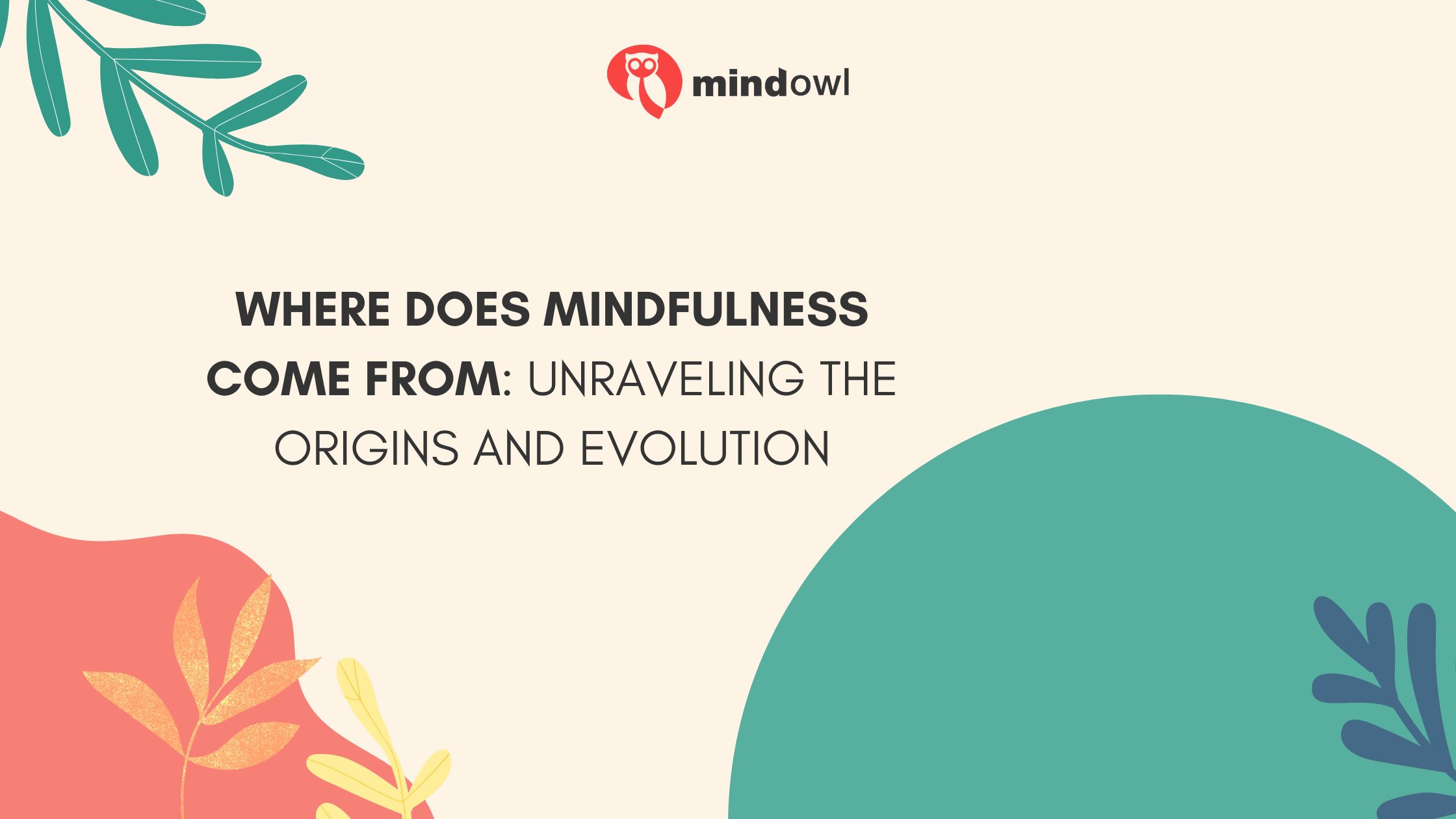
In our fast-paced world, finding peace of mind can often seem like a distant dream. Mindfulness, with its ancient wisdom, offers a sanctuary within the tumult of daily life. This article will delve into the rich tapestry of mindfulness’s past, guiding you through its transformative journey from Eastern philosophy to modern-day practice.
Discover the timeless art of presence and how it can illuminate your path to tranquillity—let’s explore together.
Key Takeaways
- Mindfulness started a long time ago in Hinduism and Buddhism, where it was part of meditation.
- Jon Kabat – Zinn brought mindfulness to many people in the West by starting the MBSR programme.
- Mindfulness means paying attention to now and being kind to yourself, even when your mind wanders.
- Practising mindfulness can make your mind healthier. It helps you focus better and feel less stressed or sad.
- Nowadays, anyone can learn about mindfulness. There are apps and online courses that teach how to be mindful.
The History and Origins of Mindfulness

The history and origins of mindfulness can be traced back to Hinduism and Buddhism, where it was initially practiced as a form of meditation. Over time, mindfulness evolved in the West, leading to its integration into modern psychological and medical practices.
Origins in Hinduism
Hinduism gave us the first glimpse of what we now call mindfulness. Ancient Hindu scriptures talk about a kind of meditation called “dhyana”. This practice was key in helping people clear their minds and find peace.
The idea of “sati” in Hinduism is also a big part of where mindfulness comes from. Sati means being aware and getting to know oneself, which is just like the mindfulness we know today.
Mindfulness didn’t stop there; it grew as time went on. People kept using these ancient ways but added new ideas over time. As people shared what they learned, the practice spread wide and far.
In this way, Hindu beliefs laid the groundwork for all kinds of mindful meditation that came later, including those found in Buddhism and other traditions worldwide.
Influence from Buddhism
Buddhism brought new ideas to mindfulness. The teachings of Buddha are a big part of where mindfulness comes from. They talk about sati, which means being aware and paying attention.
This idea is found in many Buddhist meditation styles like Zen, Vipassanā, and Tibetan practices.
Mindfulness got very important in Buddhism. It helps people understand their minds better and find peace. Many Buddhist monks teach how to be mindful when they breathe or walk. They say this can make life better.
Mindfulness has grown because these old ways have spread all over the world, mixing with other ideas and changing as they go.
Evolution in the West
Mindfulness made a big leap in the West thanks to Jon Kabat-Zinn. Back in New York, he started something called Mindfulness-Based Stress Reduction or MBSR for short. This programme mixed mindfulness with science and helped many people feel less stressed.
It showed that old wisdom could help with modern problems.
Books about mindfulness also spread the word far and wide. People all over started reading about it, trying it out, and seeing how it changed their lives. They learned how to pay attention to now, rather than worry about yesterday or tomorrow.
The practice grew strong roots in Western soil, branching out into schools, offices, and hospitals everywhere.
Definition of Mindfulness

Mindfulness means paying full attention to what is happening right now, without wishing it were different. It involves being kind and forgiving towards yourself when your mind wanders off.
This awareness brings many benefits, helping people feel less stressed and more calm.
To practice mindfulness, you focus on your thoughts, feelings, body sensations, and the world around you. This helps you notice signs of stress or anxiety earlier and deal with them better.
Mindfulness also includes accepting things as they are without judging them or trying to change them too quickly. Embracing the unalome meaning within the practice emphasizes the transformative nature of the journey towards mindfulness and enlightenment.
Mindfulness Practice
Mindfulness practice involves cultivating a sense of awareness and being present in the moment, often through meditation and breathing exercises. To learn more about the key elements of mindfulness practice and how it relates to yoga, keep reading!
Key elements of mindfulness practice
Mindfulness practice helps us focus on the present. It allows us to accept our experiences without judgment.
- Paying attention: Be fully aware of what you’re doing right now. Whether you’re eating, walking or breathing, focus your mind on that moment.
- Accepting feelings: Notice your thoughts and emotions without saying they’re good or bad. If you feel sad, don’t push the sadness away. Instead, understand it’s just a feeling that will pass.
- Living in the moment: Try not to think about the past or worry about the future. Stay with the current moment, enjoying a sunset or the taste of your food.
- Being patient: Understand that things take time to unfold. Patience is about letting life happen at its own pace, rather than rushing through it.
- Letting go: Release thoughts and sensations that come up during mindfulness exercises. Imagine them floating away like leaves in a stream.
- Trusting yourself: Have confidence in your feelings and intuition. Believing in yourself is an important part of mindfulness.
- Not striving for perfection: Understand that there’s no right way to practice mindfulness; it’s about your personal journey and growth.
- Having an open mind: Be curious about your experiences during mindfulness practice. Like seeing things for the first time, explore your surroundings with wonder.
How mindfulness relates to yoga
Mindfulness and yoga are close cousins in the world of wellness. Yoga uses physical poses, breathing techniques, and meditation to boost both body and mind health. Mindfulness taps into this by focusing on the present moment during these exercises.
It’s all about being aware of your body, thoughts, and feelings without judgement as you move through different yoga positions.
Practising mindfulness in yoga means paying full attention to each stretch and breath. This helps calm the mind and teaches patience as well as self-compassion. So while you’re holding a pose or taking deep breaths in yoga, adding mindfulness can make the experience even richer for your mental peace.
The Science of Mindfulness
Research has shown the numerous mental and physical benefits of mindfulness practice, indicating its potential to improve overall well-being. To learn more about this fascinating topic, keep reading!
Research on the benefits of mindfulness practice
Mindfulness meditation helps you think about your own thinking. This is called metacognitive awareness. When people practice mindfulness, they don’t get caught up in the same old thoughts as much.
They learn to let go of these thoughts instead of going over them again and again. Studies show that being more mindful can make people feel better inside their minds. It can help calm down problems like feeling sad or worried.
Some scientists have found out interesting things about mindfulness by talking to people who practice it. They’ve learned that mindfulness makes you more aware of how you feel, even when those feelings are tough or uncomfortable.
But for some folks, paying close attention to difficult emotions might make their psychological problems worse before they get better. That’s why it’s important to be careful and maybe get help from a teacher when trying new things like mindfulness meditation.
How mindfulness can improve mental and physical well-being
Originating in ancient Buddhist teachings, mindfulness has garnered significant attention for its potential to enhance mental and physical well-being. Scientific research supports the positive impact of mindfulness meditation on psychological health, showing that it can increase mindfulness levels and reduce negative psychological symptoms.
Furthermore, psychologists have discovered that engaging in mindfulness meditation can bring about constructive changes in the brain and biology, leading to improvements in both mental and physical health.
These findings underscore the value of incorporating mindfulness practices into daily routines as a means to boost overall well-being.
Moreover, evidence suggests that practising mindfulness meditation can result in an enhancement of psychological well-being by increasing mindful awareness while diminishing adverse psychological symptoms.
Additionally, research indicates that engaging in mindfulness meditation endeavours may lead to positive alterations within the brain and biology, thereby contributing to improved mental and physical health.
The evolution of mindfulness-based interventions
Having understood the science behind how mindfulness can improve mental and physical well-being, it’s essential to recognise the evolution of mindfulness-based interventions. The history of mindfulness can be traced back hundreds of years and is rooted in Buddhist teachings.
Over time, this practice has transcended its spiritual origins to become integrated into modern psychology and medicine.
Mindfulness-based interventions have shown moderate improvements in depression, as supported by a comprehensive meta-analysis of randomised clinical trials. This evidence supports the association of structural and functional changes in the brain with mindfulness meditation.
Conclusion
In conclusion, mindfulness has deep roots in ancient Eastern philosophy and Buddhist teachings. Over time, it has evolved and migrated to the West, becoming accessible to modern society.
The history of mindfulness is complex and continues to evolve as it integrates into various fields, such as psychotherapy, medicine, education, and the workplace. Its rich origins and scientific research showcase its significance for mental well-being in today’s world.
FAQs
1. What is the origin of mindfulness?
The roots of mindfulness go back to ancient Buddhist meditation techniques, but the practice has evolved into a scientific approach that many people use for stress reduction and mental well-being.
2. How did mindfulness begin in the West?
Mindfulness in the West started when Zen meditation teachers introduced meditation by a Zen missionary, which later blended with local practices to form modern mindfulness methods.
3. Can anyone learn about mindfulness?
Yes, anyone can practise mindfulness; it’s become widely taught through courses like Mindfulness-Based Stress Reduction at places like the University of Massachusetts Medical Centre for Mindfulness.
4. Is there evidence that practising mindfulness is good for you?
Research on mindfulness suggests that this practice can improve your mental health and reduce stress, while other studies show measurable benefits for physical health too.
5. Are there different types of mindfulness practices?
Many types of mindful exercises exist today because several traditions have been integrated over time—like insight meditation from Buddhism or combinations used in structured programmes such as eight-week Mindfulness courses.
6. Has how we view and practise meditation changed over time?
Yes! Originally a part of spiritual rituals, interest in meditative practices went on to study its effects scientifically; now it’s often seen as therapy or a way to boost emotional control and encourage peaceful living.
MindOwl Founder – My own struggles in life have led me to this path of understanding the human condition. I graduated with a bachelor’s degree in philosophy before completing a master’s degree in psychology at Regent’s University London. I then completed a postgraduate diploma in philosophical counselling before being trained in ACT (Acceptance and commitment therapy).
I’ve spent the last eight years studying the encounter of meditative practices with modern psychology.

